
Oman Roadtrip – Our route from Muscat to Nizwa
I didn’t have Oman on my travel radar. Until, by chance, I discovered the wonderful film “12 days in Oman” by Marko Roth and my wanderlust was awakened. After a few conversations with friends and acquaintances who have traveled to Oman, the decision for the Easter holidays was made spontaneously on a Wednesday evening. Oman instead of Holland and East Frisia. It was clear from the beginning that we wanted to explore the country with a rental car (as a self-driver). Even though we have met many tourists who have been traveling with a driver or with tour operators, Oman is ideal for individual road trips. The route planning took two or three evenings, because the localization of the respective places usually did not work right away due to the different spellings. Even locally, the same villages are translated differently depending on the panel. With a time budget of 10 days, it was clear from the beginning that detours to tropical Salalah and the fjords on the Musandam peninsula would not be possible. We limited ourselves to the regions of Al Batinah, Al Dakhliyah and Al Sharqiya within a radius of about 250 km around Muscat. A typical beginner’s route that can be explored stress-free in ten days.
Day 1 – from Muscat via Wakan to Mussanah
Planning a 300 km route right after landing at Muscat Airport is not for everyone. Most tourists spend at least the first night in Muscat. But we wanted to treat ourselves to two beach days in Muscat at the end of the road trip. That’s why we ventured out onto the streets immediately after the six-hour direct flight with landing time of 7.20 a.m. I had booked our car in the Premium PFAR category including medium protection package and navigation system with Europcar and paid in advance. Accordingly, our Oman road trip started disappointingly when we were told that there were no more navigation systems available. They did not want to refund the money directly on site, but referred to the customer service, which I should inform by e-mail. Once again, a terrific performance by Europcar. My mood didn’t get any better when I saw which car was intended for us. A filthy GMC with a broken trunk door. After I refused to accept this car, I was at least offered a clean and functional GMC model. I grumbled and agreed – this type of car did not correspond to the one we had reserved, but was classified one category higher. And I was fundamentally disgusted to drive such a monster. But we had to rely on 4×4 due to the choice of route and there were no vehicles of our booked category on site. The next disillusionment followed when looking at the tank, which was only 1/4 full (we had booked full/full), but by then we were already on the highway towards Barka. Well.
First we stop in Nakhal, where we visit the fort (entrance fee 500 baizas per person – ticket prices are the same for all forts). Afterwards we turn into Wadi Mistal. At the very back, at almost 2,000 m above sea level, the village of Wakan sits enthroned in a spectacular location high above the valley. The road is paved until about 3 km before the village. After that, the surface abruptly changes to a bumpy, steep and narrow track that winds its way up to the village in curves. For me, this is the test drive for the planned off-road ride through Wadi Bani Awf. And amazingly, I manage the route without drama despite the “monster truck”. A worthwhile detour. Afterwards we drive via al Abyad back to the coast to Mussanah, where we enjoy the gentle sea breeze and relax for the rest of the afternoon.
Mileage: 280
Overnight: Millennium Resort Mussanah




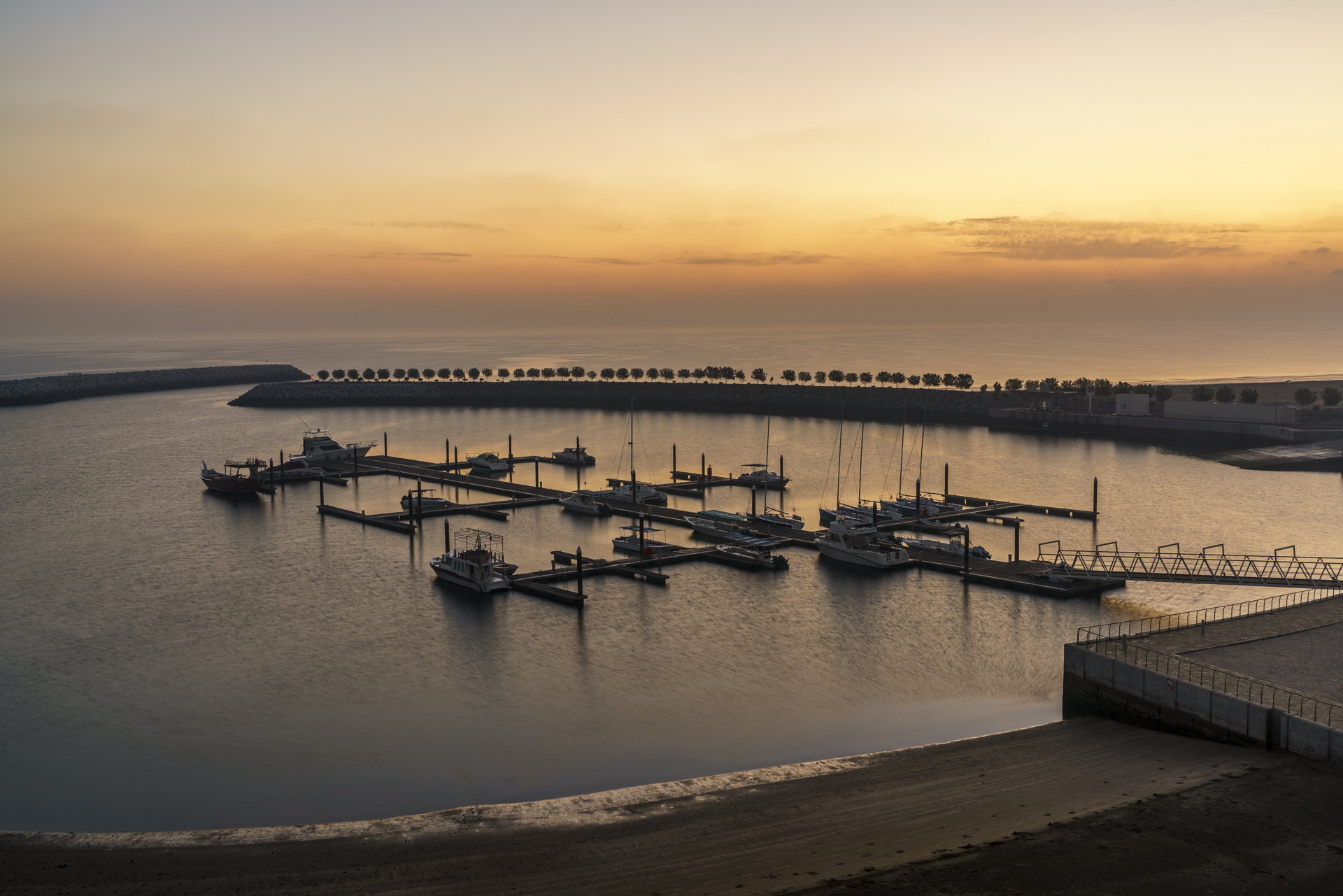
Day 2 – off-road through Wadi Bani Awf to Nizwa
In terms of driving, the heart of the program is on the second day. The off-road route through the Wadi Bani Awf to al Hamra. Over the past twenty years, Sultan Qaboos has invested a lot of money in the expansion of infrastructure. Many roads that existed a few years ago in the form of a gravel road are now perfectly developed with two or even four lanes and equipped with street lights every 100 m (which made me smile on remote stretches). However, it still has some villages and wadis that can only be reached via slopes. Due to the steep gradients (some of which are so steep that you have the feeling that you are driving into the “void”), 4×4 vehicles are mandatory for these routes. And because of the many stones, a car with a lot of clearance (front and rear) would be an advantage. The GMC is built rather low at the front, which promptly became my undoing at an alternate point. I haven’t received the final bill yet, so I don’t know if the paint scratch will cost me what.
Apart from this mishap, the drive through Wadi Bani Awf was a highlight of our trip and took us amidst the rugged beauty of Oman. It is important to plan enough time and not to forget the weather. When it rains, the wadis can turn into travelling rivers in a very short time and then it is no longer possible to get through. At one point, even in this dry weather, I was surprised at how deep I suddenly stood in the water.
Halfway to al Hamra, don’t miss the turn-off to Bilad Sayt on the right. The short detour to the picturesque mountain village surrounded by palm groves is worthwhile. Out of consideration for the local population, restraint must always be maintained (no shorts, at least covered shoulders). After Bilad Sayt, the track winds its way up the mountain flanks in sometimes breakneck steep curves. The change from piste back to paved road takes place at the highest point of the route at the border between Al Batinah and Al Dakhliyah. If you don’t rent a 4×4 car, you can at least marvel at the view over Wadi Bani Awf up here. After another short detour to the mountain village of Misfah, which is also worth seeing, where we fortify ourselves with tea and dates, we drive to our accommodation near Nizwa.
Mileage: 200
Overnight: Golden Tulip Nizwa Hotel
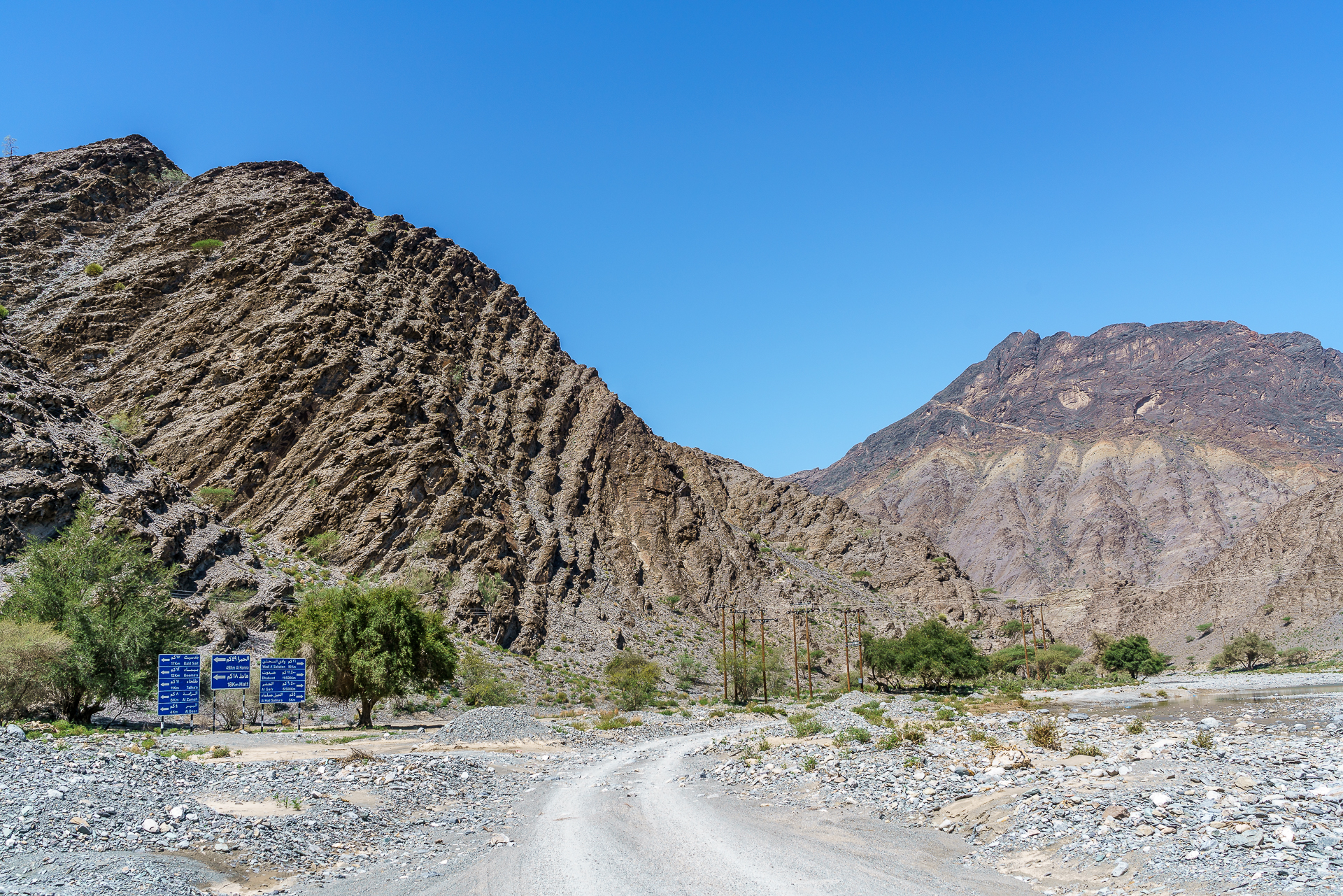








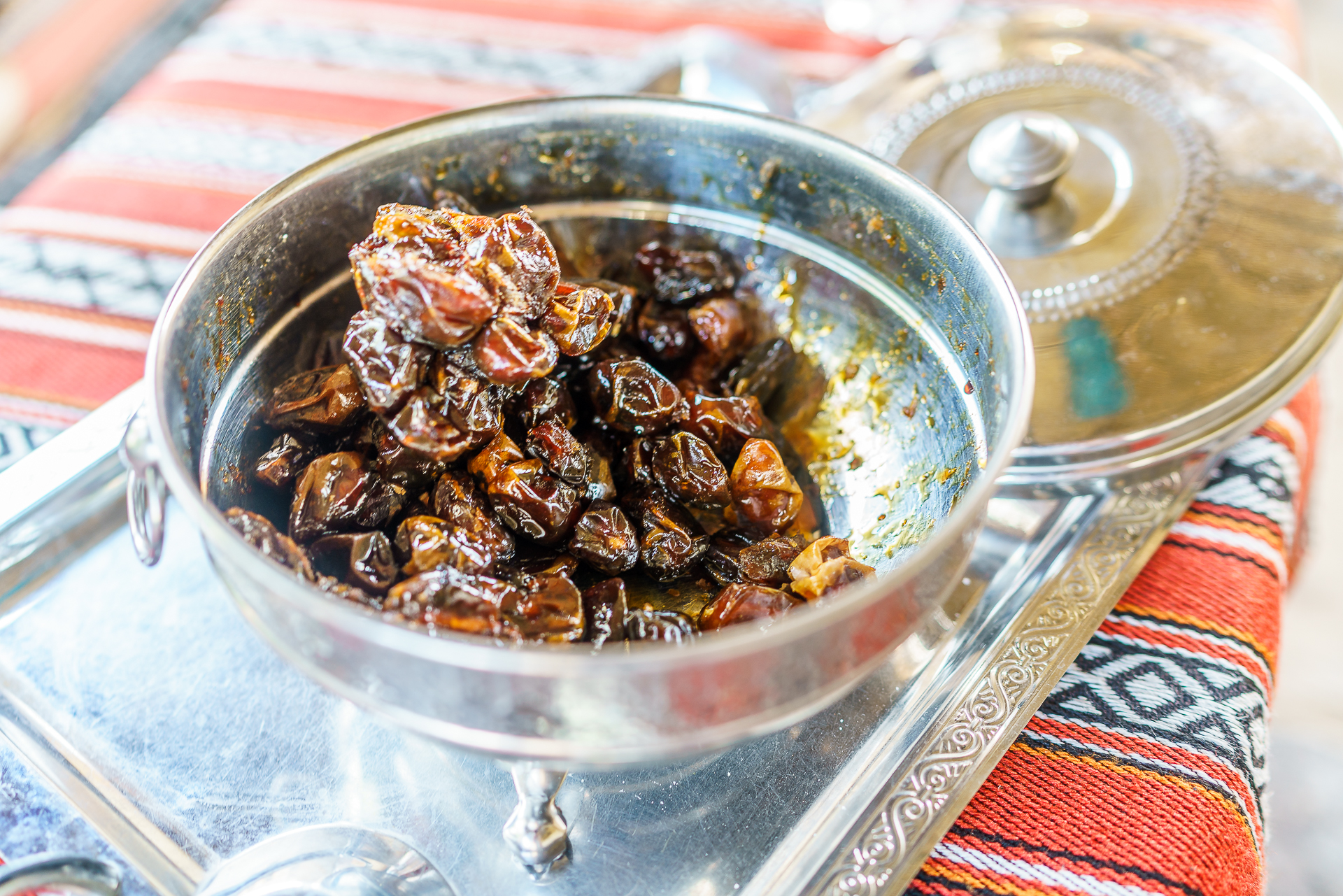
Day 3 – Jebel Shams, Bahla Fort and Jabrin Castle
There is so much to see around the old capital Nizwa, so we planned a full day for this area. In the early morning we make our way to Jebel Shams, which is the highest mountain in Oman at almost 3,000 m above sea level. On the way there, we pass the village of Guhl, whose old mud houses have been abandoned for a long time and are slowly crumbling. The new concrete houses are located further down the road.
After about an hour’s drive over an initially paved track, which gives way to a track further up, we reach the plateau. The view of the deeply cut Wadi Nakhar, which is considered the Grand Canyon of Oman, is impressive, 800 metres further down. A panorama that is difficult to capture in a picture. Afterwards we visit the fortress Hisn Tamah (Bahla Fort), which has been a UNESCO World Heritage Site since 1987 and is the most imposing castle in Oman with its numerous defensive towers. Not far from Bahla is the Jabrin Castle, which is also worth seeing. Since the oasis of Jabrin has dried up for a long time, the population was relocated and the castle now stands alone in the landscape.
Mileage: 200
Overnight: Golden Tulip Nizwa Hotel
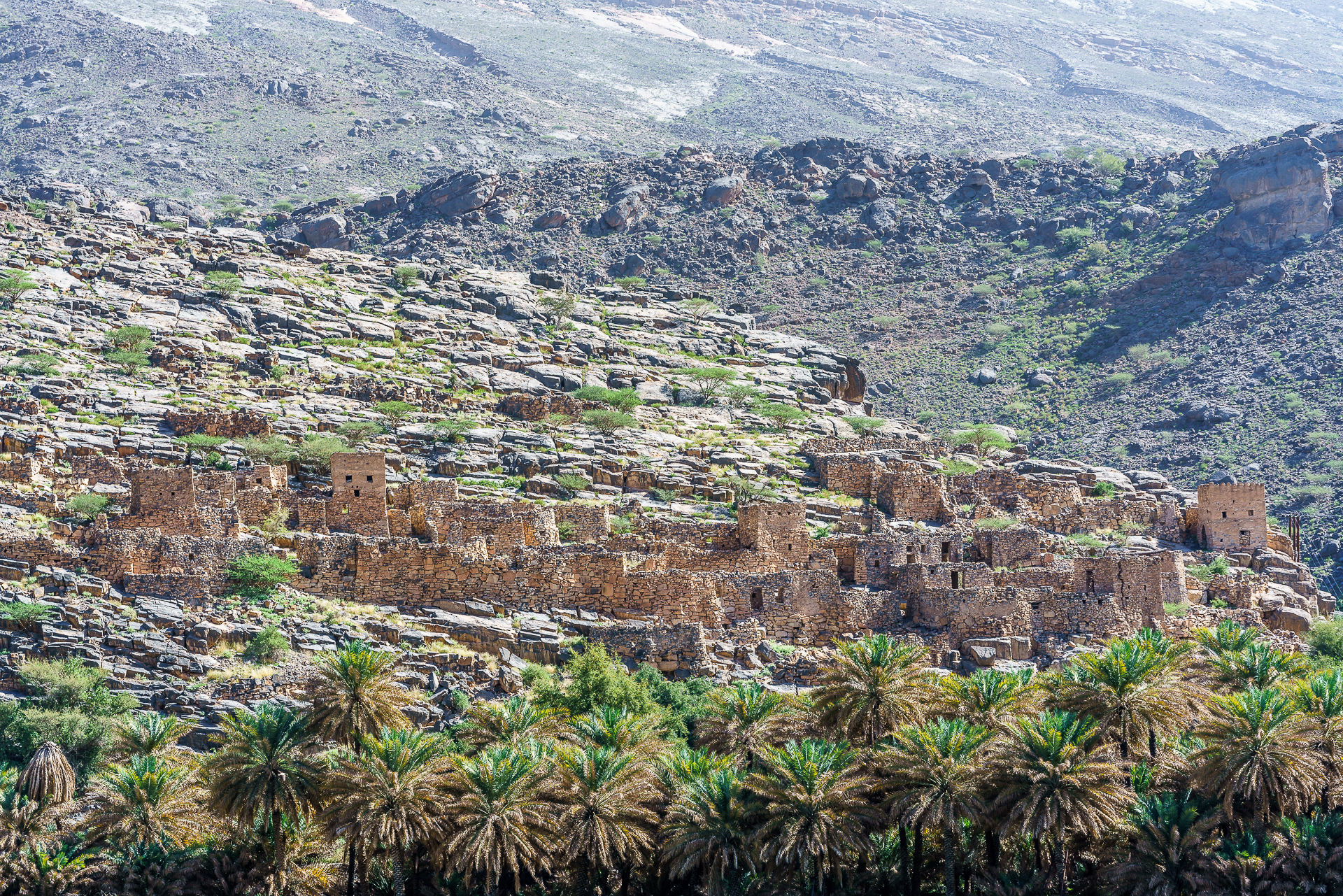







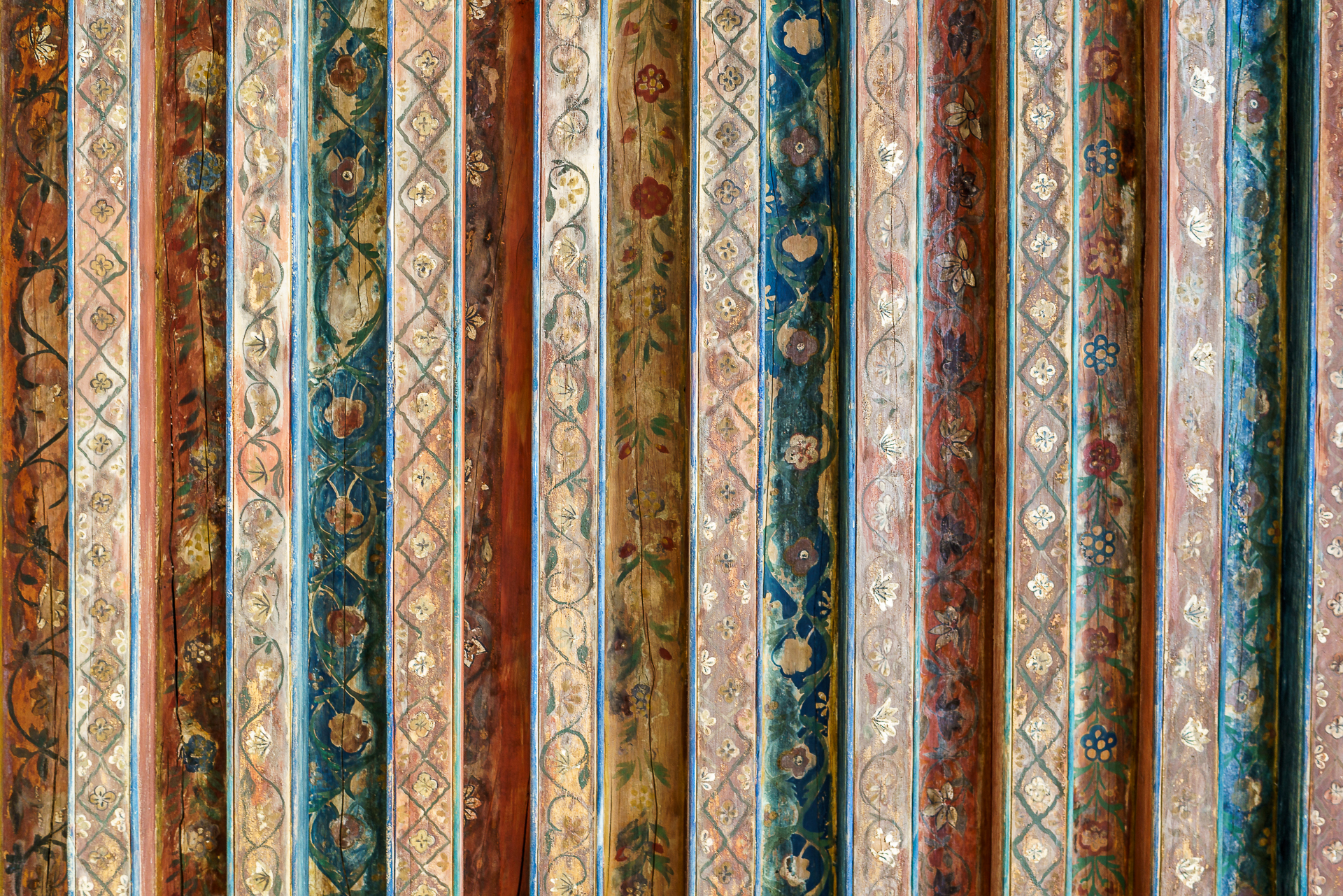
Tag 4 – Nizwa, Birkat al Mouz, Jabal Akhdar
The next morning we stop first in the old core of Nizwa, which presents itself with its fort, mosque and souk squeaky clean. Unfortunately, we were in Nizwa on a Sunday / Monday and missed the legendary animal market, which takes place every Friday. Afterwards we make our way to the Saiq Plateau. Before you turn off in Birkat al Mouz (depending on the spelling also Birkat Al Mawz) onto the road to the plateau, you should take a short walk through the village center. Here you can see a particularly outstanding Falaj specimen. The irrigation technology is also a UNESCO World Heritage Site and originated in the Arabian Peninsula (the same system can also be found on the dry slopes of the Alps or in Madeira).
Mileage: 60
Overnight: Alila Jabal Akhdar







Day 5 – with a stop in Ibra to the Wahiba Sands
After a relaxing afternoon in the beautiful Alila Jabal Akdhar and a delicious breakfast with a view of the rugged mountain landscape, the desert stage is on the agenda. Before we leave the mountains behind us, we go in search of “Diana’s view point”. Named after Princess Diana, the viewpoint offers panoramic views of the ancient mountain villages of Wadi Bani Habib, Saiq and Al Ayn and their terraced fields. The Anantara Al Jabal Al Akhdar Resort is currently under construction there. However, the viewpoint remains open to the public. Halfway into the desert, we treat ourselves to a small Indian snack bar in Ibra (right next to the Ibra Motel). The cuisine in Oman is generally strongly influenced by Indian cuisine and if you are looking for restaurants that do not belong to a hotel, you will mostly end up in Indian restaurants. We were kindly served everywhere and ate well.
Mileage: 250
Overnight: Desert Nights Camp

Tag 6 – Wadi Bani Khalid, Sur, Wadi Shab
One of the most visited and greenest wadis is the Wadi Bani Khalid – even though it is only a few kilometers away from the Wahiba Desert as the crow flies. In the front part there is a tourist infrastructure with pools and seating. If you like to scramble over stones, you can work your way up and find more, naturally formed pools with pleasantly cool, deep blue water. An oasis as you would imagine it. The humid air catches up with us in the Sur. The coastal town shimmers in the midday heat and the white sandy beach is understandably deserted. After a few meters on foot, our shirts stick to our backs and we see each other after cooling down. We find them in an Indian snack bar just behind the beach promenade.
The goal of photographing the last light of the day in Wadi Shab would have to be thrown overboard due to too much water. Access to the wadi can only be reached by motorboat and the skipper wants to finish work at 5:30 p.m. at the latest. Cost of the crossing: 100 baizas per person round trip. We can delay the end of the day until 6:00 p.m., which is at least enough for an insight into the extensive wadi. However, you would have to hike/scramble into the wadi for a good two hours to get to the idyllically situated pools.
Mileage: 220
Overnight: Wadi Shab Resort
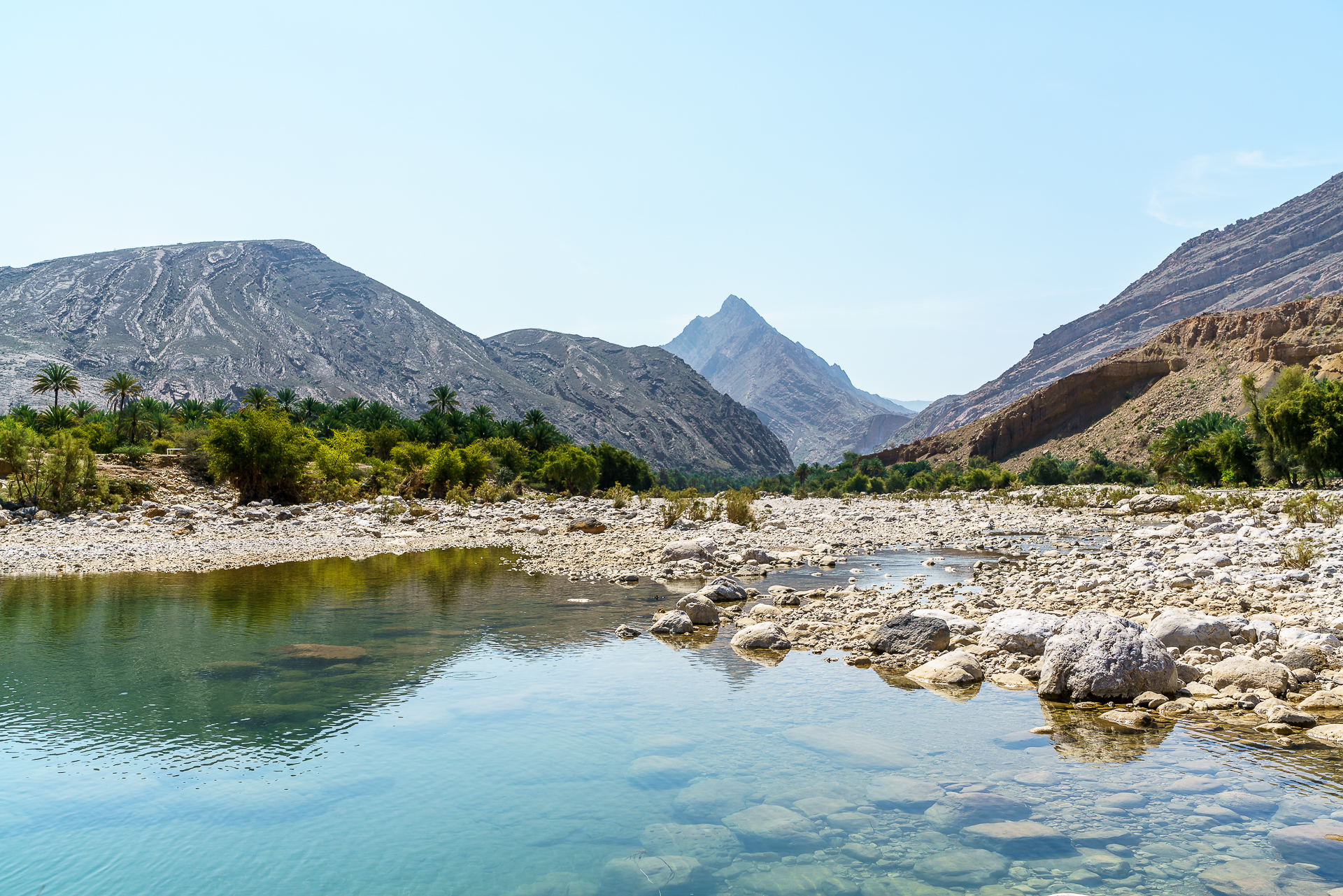



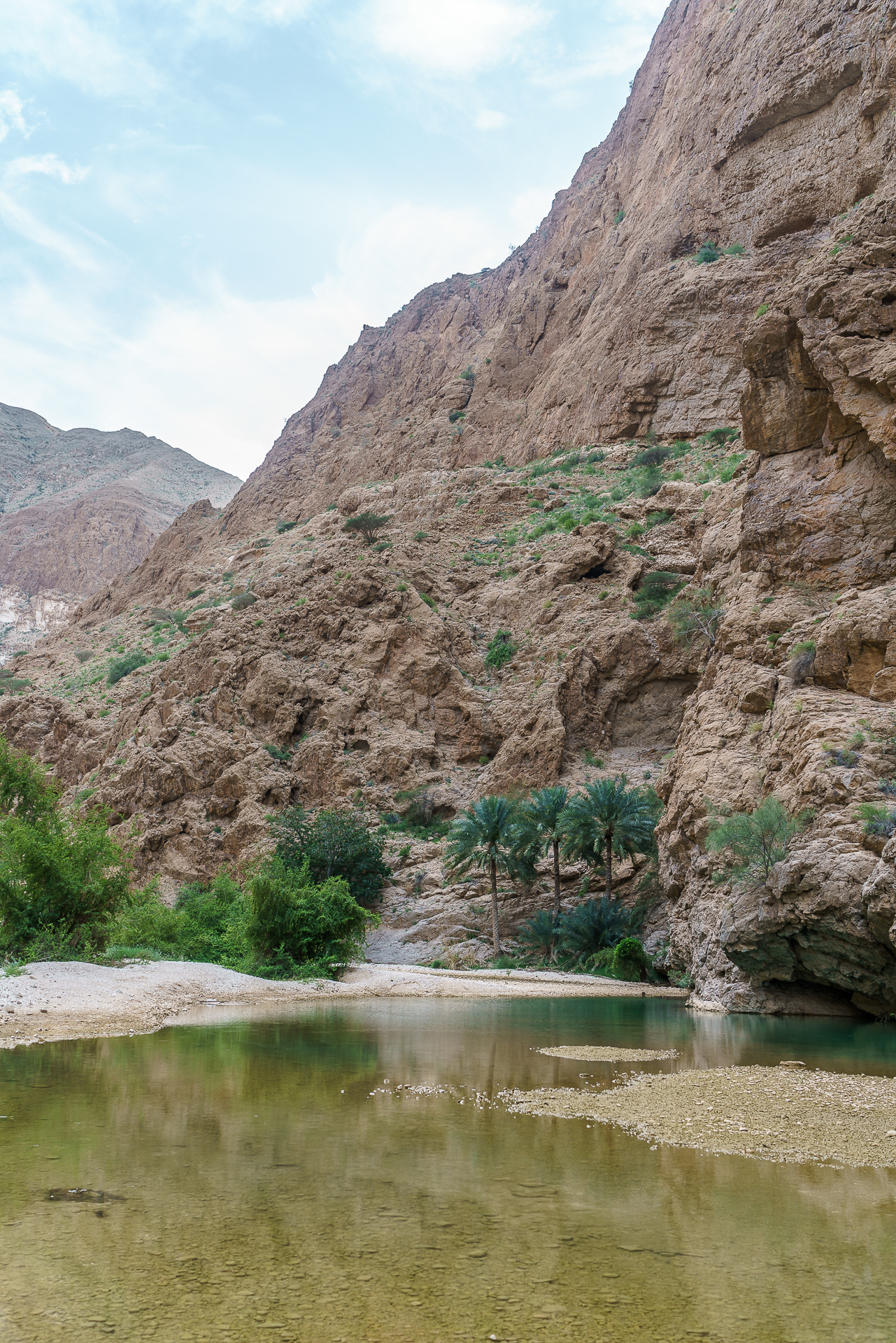
Tag 7 – Bimmah, al Khiran, Muscat
The highlight of the last leg of our Oman road trip is the sinkhole between Bimmah and Dibab. At Fins we turn off the highway and drive along the old coastal road to Dibab. Here you can stop in between and marvel at the endlessly long, undeveloped pebble beach. Also worth seeing is the fishing town of Quriyat, where the beach promenade is mainly used for the recreation of goats. Anyway. Goats, sheep and donkeys can be seen from time to time on the roadside. If a car is honking its lights towards you, 90% of the time it means that there are goats on the road.
Since I really wanted to see the mangrove forests and fjord-like bays at Al Khiran, we were able to enjoy an off-road ride through the Wadi Yiti (turnoff at Al Hajar) in the last kilometers before Muscat. From Al Khiran to Muscat we followed the narrow, winding Yiti Street and reached the Ruwi district unplanned via a pass road that offers a great view of the district. Not so great was the route search across the hustle and bustle of Ruwi to our destination in the district of Al Ghubrah. But we successfully muddled through the Omani traffic. Because even if the Omani tend to drive much too fast, they are otherwise very accommodating and not jostling. If you want to get in, you will be let in.
Mileage: 200
Overnight: The Chedi Muscat



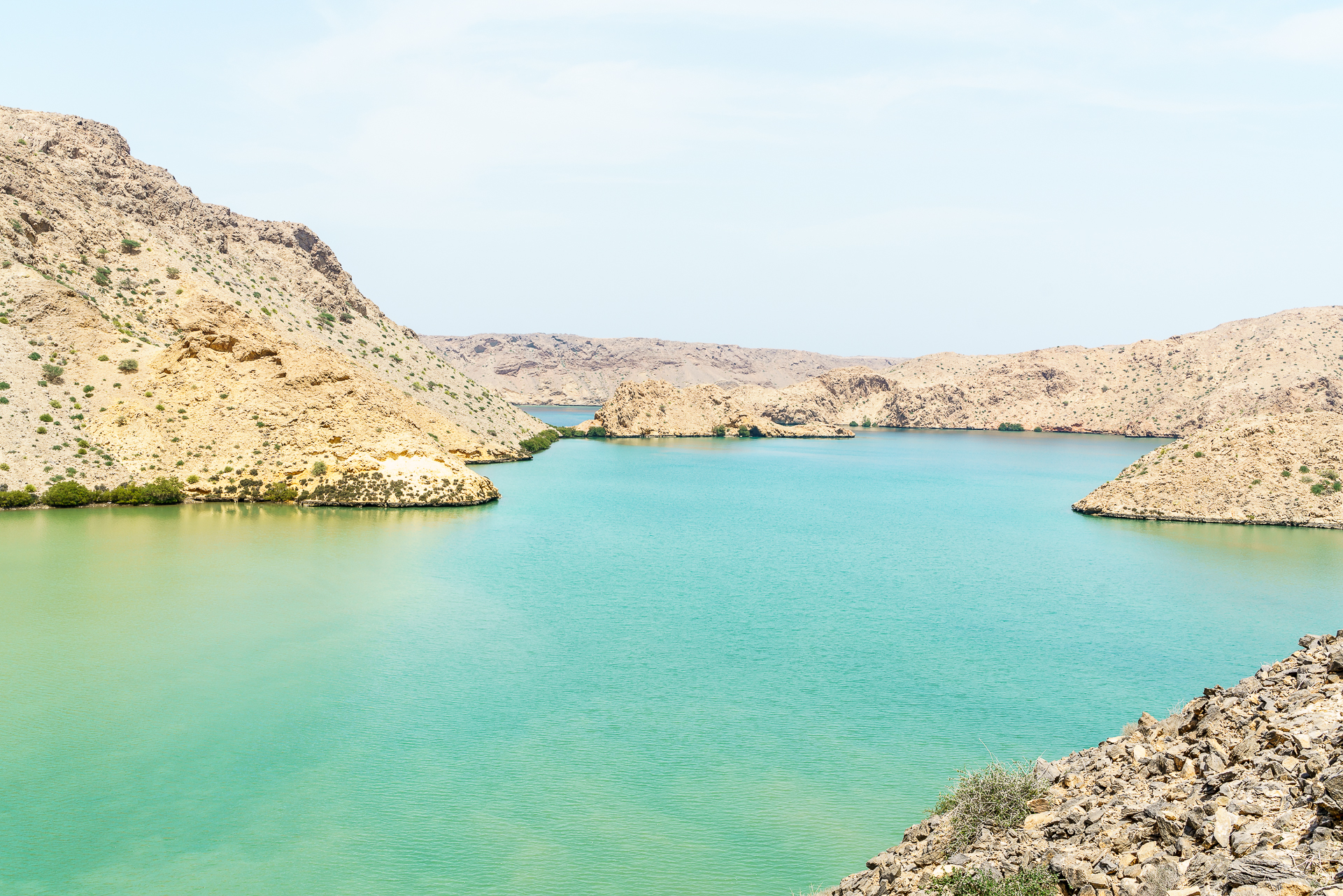


Oman Road Trip – Practical Tips
- All important road signs are written in Arabic and English
- There is traffic on the right-hand side
- Many speed cameras are installed on the four-lane motorways (maximum speed 120 km/h)
- There is a lot of construction going on – the navigation systems must therefore be equipped with the latest maps (old maps cause confusion)
- Our biggest problem with navigation was that we couldn’t find some places due to the different spellings
- We followed the route suggestions of Google Maps and only drove 1x wrong
- Omani communicate in traffic with “flashing” (trucks flashing right or left depending on whether the road is clear to overtake), “honking lights” (in case of danger on the road) and hand signals (in the countryside, practically every oncoming driver greets you with hand signals).
- At wadi crossings, white/red marked posts indicate when the water is too high
- An international driver’s license is not mandatory (you should have one with you when driving through the UAE)
- The car can be parked in parking lots without hesitation (deep crime)
- The petrol stations are all serviced. Only cash is accepted (in addition to the Shell Card). A full tank of fuel (example 70l tank) costs around 12 OMR
- We paid 900 CHF for the rental car (GMC Yukon SLT) for 9 days incl. unlimited mileage, medium protection package and GPS
- Attention: many car rental companies only offer limited mileage per day
Update February 2018: Due to popular demand, here are the key points of our road trip in map form. If you have any questions about the Oman road trip, please ask them here in the comments so that other readers can also benefit from it – Merci! :)


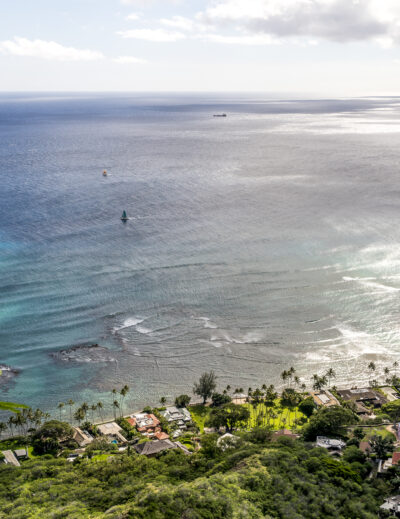


Leave a Reply